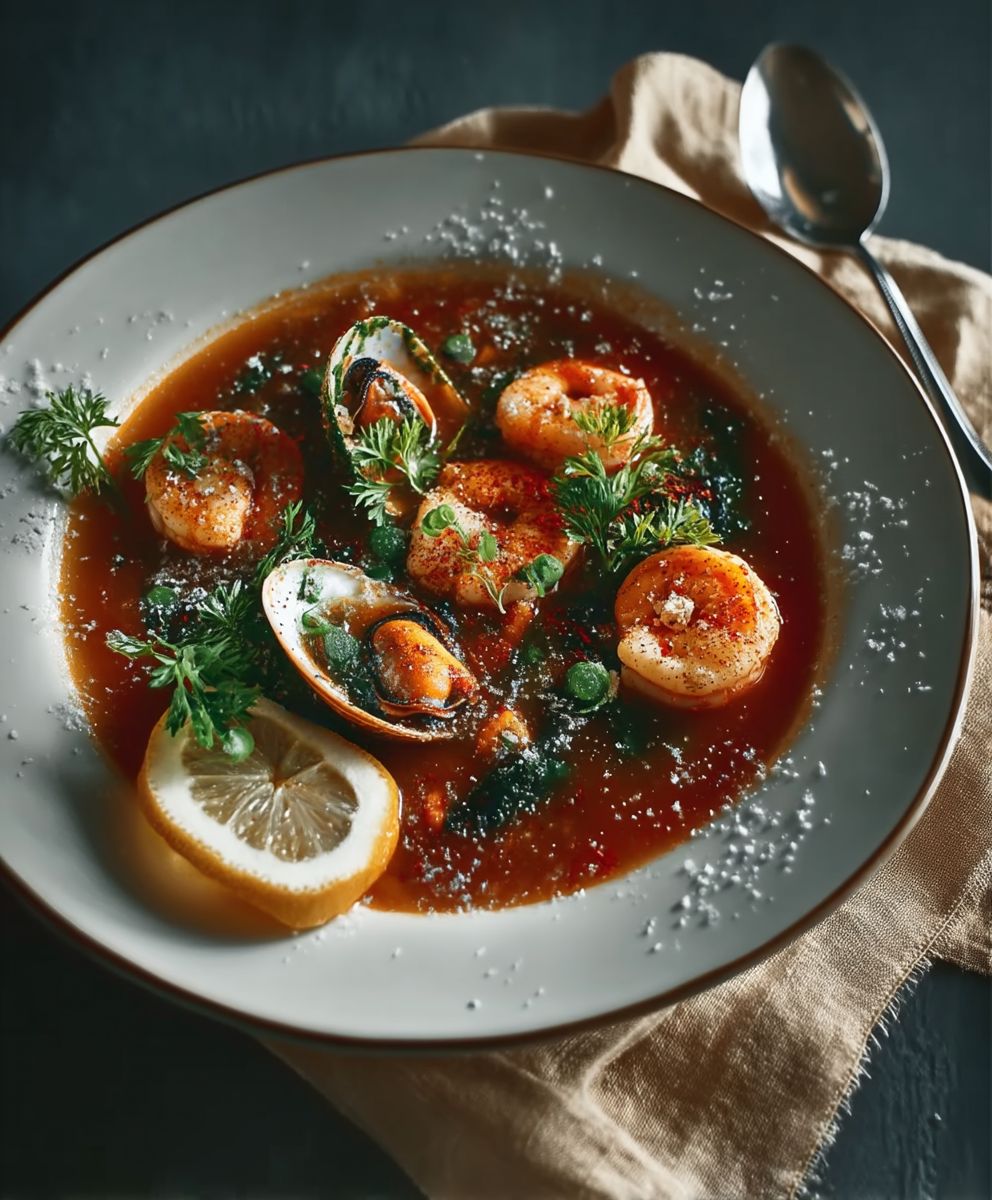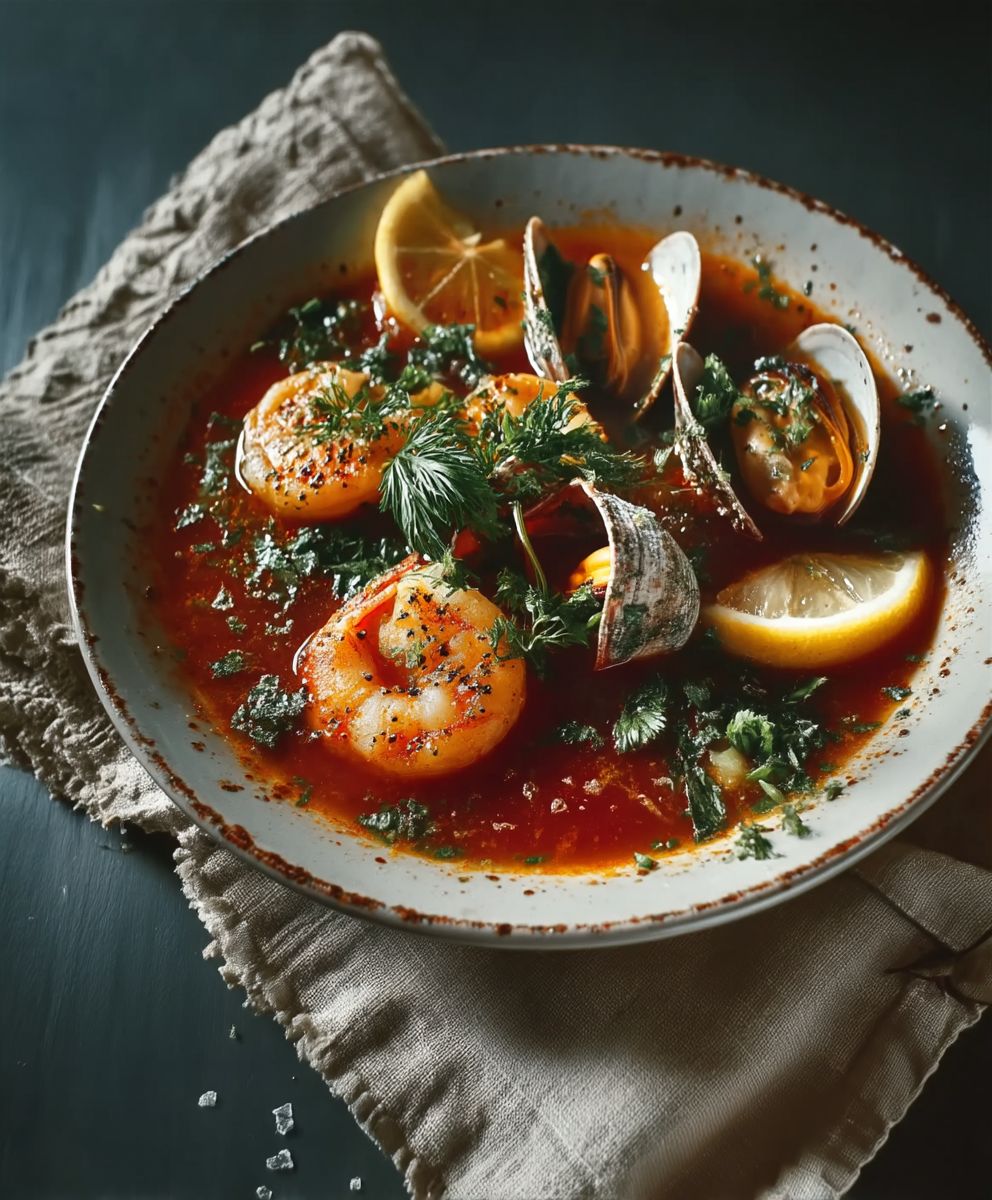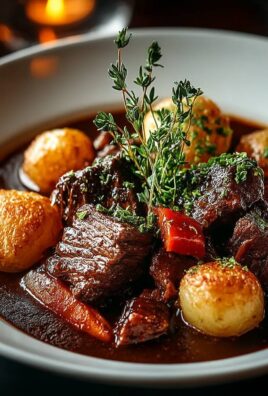Classic French Fish Stew, or Bouillabaisse as it’s known in the South of France, is more than just a soup; it’s an experience! Imagine a vibrant, aromatic broth brimming with the freshest seafood, each bite a burst of oceanic flavor. Have you ever dreamt of transporting yourself to the sun-drenched shores of Marseille with just one spoonful? Well, get ready to pack your bags (figuratively, of course!) because this recipe will do just that.
Bouillabaisse boasts a rich history, originating as a humble fisherman’s stew made with the day’s unsold catch. Over time, it evolved into a celebrated culinary masterpiece, a testament to the resourcefulness and passion of Provençal cooks. The key to an authentic Bouillabaisse lies in the quality and variety of the fish, the fragrant herbs de Provence, and the saffron-infused broth that ties it all together.
People adore Classic French Fish Stew for its complex flavors, the satisfying heartiness of the broth, and the delightful textures of the various seafood. It’s a dish that’s both comforting and elegant, perfect for a special occasion or a cozy weeknight dinner. Plus, while it might seem intimidating, this recipe is surprisingly straightforward, allowing you to create a restaurant-worthy meal in the comfort of your own kitchen. So, let’s dive in and discover the secrets to making the perfect Bouillabaisse!
Ingredients:
- 1.5 lbs firm white fish fillets (cod, halibut, or sea bass), cut into 2-inch pieces
- 1 lb mussels, scrubbed and debearded
- 1 lb clams, scrubbed
- 1/2 lb large shrimp, peeled and deveined
- 1 large onion, chopped
- 2 leeks, white and light green parts only, thinly sliced and washed thoroughly
- 4 cloves garlic, minced
- 1 red bell pepper, seeded and chopped
- 1 fennel bulb, thinly sliced, fronds reserved for garnish
- 1 (28 ounce) can crushed tomatoes
- 1 (14.5 ounce) can diced tomatoes, undrained
- 1 cup dry white wine (such as Sauvignon Blanc or Pinot Grigio)
- 4 cups fish stock (or seafood broth)
- 1/2 cup Pernod (or other anise-flavored liqueur)
- 1/4 cup olive oil
- 2 tablespoons tomato paste
- 1 teaspoon saffron threads
- 1 teaspoon dried thyme
- 1/2 teaspoon red pepper flakes (optional)
- 1 bay leaf
- Salt and freshly ground black pepper to taste
- Fresh parsley, chopped, for garnish
- Crusty bread, for serving
Preparing the Base:
- First, let’s get our aromatic base going. In a large, heavy-bottomed pot or Dutch oven, heat the olive oil over medium heat. Add the chopped onion and leeks. Cook, stirring occasionally, until softened and translucent, about 5-7 minutes. We want them nice and soft, but not browned.
- Next, add the minced garlic, chopped red bell pepper, and sliced fennel bulb to the pot. Continue to cook, stirring frequently, for another 3-5 minutes, until the vegetables are fragrant and slightly softened. This step is crucial for building the depth of flavor in our stew.
- Now, stir in the tomato paste. Cook for about 1 minute, stirring constantly, to allow the tomato paste to caramelize slightly. This will add richness and depth to the stew. Don’t let it burn!
- Pour in the dry white wine and Pernod (or anise-flavored liqueur). Bring to a simmer and cook for 2-3 minutes, allowing the alcohol to evaporate. This will leave behind the wonderful flavors of the wine and anise.
- Add the crushed tomatoes, diced tomatoes (with their juice), fish stock, saffron threads, dried thyme, red pepper flakes (if using), and bay leaf to the pot. Season with salt and freshly ground black pepper to taste. Remember, you can always add more seasoning later, so start conservatively.
- Bring the mixture to a simmer, then reduce the heat to low, cover the pot, and let it simmer for at least 30 minutes, or up to an hour. The longer it simmers, the more the flavors will meld together and deepen. This is where the magic happens! Stir occasionally to prevent sticking.
Adding the Seafood:
- Now comes the exciting part adding the seafood! First, add the mussels and clams to the pot. Cover the pot and cook for 5-7 minutes, or until the mussels and clams have opened. Discard any mussels or clams that do not open. Safety first!
- Next, gently stir in the fish pieces and shrimp. Cover the pot and cook for another 3-5 minutes, or until the fish is cooked through and the shrimp are pink and opaque. Be careful not to overcook the fish, as it will become dry and rubbery. We want it nice and tender.
Serving and Garnishing:
- Remove the bay leaf from the stew. Taste and adjust the seasoning as needed. You might want to add a little more salt, pepper, or red pepper flakes, depending on your preference.
- Ladle the stew into bowls. Garnish with fresh chopped parsley and the reserved fennel fronds.
- Serve immediately with plenty of crusty bread for dipping into the flavorful broth. Trust me, you’ll want to soak up every last drop!
Tips for Success:
- Use fresh, high-quality seafood. The better the seafood, the better the stew will taste.
- Don’t overcook the seafood. Overcooked seafood is tough and rubbery. Cook it just until it’s cooked through.
- Adjust the seasoning to your liking. This recipe is just a guideline. Feel free to add more or less of any ingredient to suit your taste.
- Serve with crusty bread. The bread is essential for soaking up the delicious broth.
- Make it ahead of time. The stew can be made ahead of time and reheated. In fact, it often tastes even better the next day!
Variations:
- Add other seafood. Feel free to add other types of seafood, such as scallops, lobster, or crab.
- Add vegetables. You can add other vegetables, such as potatoes, carrots, or zucchini.
- Make it spicy. Add more red pepper flakes or a pinch of cayenne pepper to make it spicier.
- Use different herbs. Try using different herbs, such as oregano, rosemary, or basil.
- Add a dollop of rouille. Rouille is a Provençal sauce made with garlic, chili peppers, breadcrumbs, and olive oil. It’s a delicious addition to fish stew.
Enjoy!
This classic French fish stew is a truly special dish that’s perfect for a cozy night in or a dinner party with friends. The combination of fresh seafood, aromatic vegetables, and flavorful broth is simply irresistible. I hope you enjoy making and eating it as much as I do! Bon appétit!

Conclusion:
This Classic French Fish Stew is more than just a recipe; it’s an experience. It’s a journey to the heart of French cuisine, a warm hug on a chilly evening, and a guaranteed crowd-pleaser all rolled into one delicious bowl. I truly believe that once you taste the rich, savory broth, the perfectly cooked fish, and the aromatic vegetables, you’ll understand why this dish has been a beloved staple for generations. It’s the kind of meal that creates memories, sparks conversations, and leaves everyone feeling utterly satisfied.
Why is this a must-try? Because it’s surprisingly simple to make, yet delivers an incredibly complex and rewarding flavor profile. The combination of fresh seafood, fragrant herbs, and a touch of white wine creates a symphony of tastes that will tantalize your taste buds. Forget complicated techniques and hours spent in the kitchen; this recipe is designed to be accessible to cooks of all skill levels. Plus, it’s a fantastic way to incorporate healthy and lean protein into your diet.
But the best part? It’s incredibly versatile! Feel free to experiment with different types of fish depending on what’s fresh and available in your area. Cod, halibut, snapper, and even shrimp or mussels would all be fantastic additions. You can also adjust the vegetables to your liking. Fennel, leeks, or even a handful of spinach would work beautifully.
Serving Suggestions and Variations:
For a truly authentic experience, serve your Classic French Fish Stew with a crusty baguette for dipping into that luscious broth. A dollop of rouille, a traditional Provençal sauce made with garlic, chili peppers, and breadcrumbs, would also be a delightful addition. Alternatively, a simple sprinkle of fresh parsley and a squeeze of lemon juice will brighten the flavors and add a touch of elegance.
If you’re looking for variations, consider adding a pinch of saffron to the broth for a more luxurious and aromatic experience. Or, for a heartier stew, include some potatoes or chickpeas. For a spicier kick, add a pinch of red pepper flakes or a dash of hot sauce.
Don’t be afraid to make it your own! That’s the beauty of cooking it’s all about experimenting and finding what you love.
I’m so excited for you to try this recipe and experience the magic of Classic French Fish Stew for yourself. I truly believe it will become a new favorite in your household.
So, gather your ingredients, put on some French music, and get ready to create a culinary masterpiece. And most importantly, don’t forget to have fun!
Once you’ve made it, I would absolutely love to hear about your experience. Did you make any modifications? What did you think of the flavors? What did your family and friends say? Share your photos and stories in the comments below! Your feedback is invaluable and helps me to continue creating recipes that you’ll love. Bon appétit!
Classic French Fish Stew: A Delicious & Easy Recipe
A rich and flavorful seafood stew featuring a medley of fish, mussels, clams, and shrimp in a fragrant tomato and wine broth. Perfect with crusty bread!
Ingredients
- 1.5 lbs firm white fish fillets (cod, halibut, or sea bass), cut into 2-inch pieces
- 1 lb mussels, scrubbed and debearded
- 1 lb clams, scrubbed
- 1/2 lb large shrimp, peeled and deveined
- 1 large onion, chopped
- 2 leeks, white and light green parts only, thinly sliced and washed thoroughly
- 4 cloves garlic, minced
- 1 red bell pepper, seeded and chopped
- 1 fennel bulb, thinly sliced, fronds reserved for garnish
- 1 (28 ounce) can crushed tomatoes
- 1 (14.5 ounce) can diced tomatoes, undrained
- 1 cup dry white wine (such as Sauvignon Blanc or Pinot Grigio)
- 4 cups fish stock (or seafood broth)
- 1/2 cup Pernod (or other anise-flavored liqueur)
- 1/4 cup olive oil
- 2 tablespoons tomato paste
- 1 teaspoon saffron threads
- 1 teaspoon dried thyme
- 1/2 teaspoon red pepper flakes (optional)
- 1 bay leaf
- Salt and freshly ground black pepper to taste
- Fresh parsley, chopped, for garnish
- Crusty bread, for serving
Instructions
- In a large, heavy-bottomed pot or Dutch oven, heat the olive oil over medium heat. Add the chopped onion and leeks. Cook, stirring occasionally, until softened and translucent, about 5-7 minutes.
- Add the minced garlic, chopped red bell pepper, and sliced fennel bulb to the pot. Continue to cook, stirring frequently, for another 3-5 minutes, until the vegetables are fragrant and slightly softened.
- Stir in the tomato paste. Cook for about 1 minute, stirring constantly, to allow the tomato paste to caramelize slightly.
- Pour in the dry white wine and Pernod (or anise-flavored liqueur). Bring to a simmer and cook for 2-3 minutes, allowing the alcohol to evaporate.
- Add the crushed tomatoes, diced tomatoes (with their juice), fish stock, saffron threads, dried thyme, red pepper flakes (if using), and bay leaf to the pot. Season with salt and freshly ground black pepper to taste.
- Bring the mixture to a simmer, then reduce the heat to low, cover the pot, and let it simmer for at least 30 minutes, or up to an hour. Stir occasionally to prevent sticking.
- Add the mussels and clams to the pot. Cover the pot and cook for 5-7 minutes, or until the mussels and clams have opened. Discard any mussels or clams that do not open.
- Gently stir in the fish pieces and shrimp. Cover the pot and cook for another 3-5 minutes, or until the fish is cooked through and the shrimp are pink and opaque.
- Remove the bay leaf from the stew. Taste and adjust the seasoning as needed.
- Ladle the stew into bowls. Garnish with fresh chopped parsley and the reserved fennel fronds.
- Serve immediately with plenty of crusty bread for dipping into the flavorful broth.
Notes
- Use fresh, high-quality seafood for the best flavor.
- Don’t overcook the seafood. Cook it just until it’s cooked through.
- Adjust the seasoning to your liking.
- Serve with crusty bread for soaking up the delicious broth.
- The stew can be made ahead of time and reheated. It often tastes even better the next day!





Leave a Comment